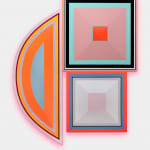Beverly Fishman American, b. 1955
162.6 x 141 x 5.1 cm
Here, the pill forms are intact, except for the crescent form, which suggests that a normally round pill has been cut in half. The title of this work is suggestive of the relationship between pain and addiction.
Fishman’s Dividose paintings are visual evocations of chemical cocktails, referencing people’s habit of taking multiple pharmaceuticals at once, sometimes needing one to mitigate the side effects of another.
As with all of Fishman’s paintings, a conversation is also playing out in this work about the relationship between our chemical reaction to pharmaceuticals and our chemical reaction to art. Abstract art historical references can be found everywhere in Fishman’s work. Here, we see pared-down, minimal shapes made from industrial mediums, referencing Minimalism and artists like Donald Judd. We see color relationships being examined in concentric squares, a reference to the Bauhaus and the teachings of Joseph Albers. We also see references to the legacy of shaped canvases—from the totally abstract, to artists like Ellsworth Kelly, who made shaped works that related to real-world forms like leaves (much like Fishman, whose forms relate to the visual vocabulary of Big Pharma.)



